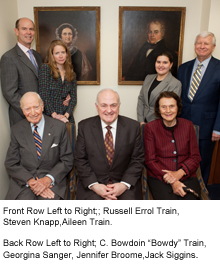By Danny Freedman
He was one of GW’s founding fathers, the man who symbolically leased the school its original plot of land for the price of one peppercorn—annually. Now his picture hangs in the office suite of President Steven Knapp, in homage to his service during the university’s earliest years.
Painted portraits of the Rev. Obadiah Bruen Brown and his wife, Elizabeth Riley Brown, were unveiled last week by Dr. Knapp and Russell Train, the great-great grandson of Rev. Brown.
“We didn’t make the gift just casually,” said Mr. Train, who recently donated the portraits and was on-hand with his wife, Aileen, and other family members.
The portraits had been hanging for years at the Trains’ farm on Maryland’s Eastern Shore, but Mr. Train—a former judge who also has served as chairman of the World Wildlife Fund, head of the U.S. Environmental Protection Agency and undersecretary of the Department of the Interior—said he thought the university would be “an appropriate home for them.”
“I’m delighted you put the portraits in such a prominent spot,” he told Dr. Knapp, who replied that he was “very honored to be able to do so.”
Mr. Train’s ancestor Rev. Brown was among the quartet of Baptist ministers who raised money, petitioned Congress for a charter and opened the Columbian College in 1821. (It wasn’t until 1904 that the school became known as The George Washington University.)
Rev. Brown was “extremely important not just to the founding of the university but making it sustainable, certainly in its early period,” perhaps more than any other person, says University Librarian Jack Siggins.
Rev. Brown served as the inaugural head of the college’s Board of Trustees and often even filled in for the school’s first president, according to the 1970 university history Bricks Without Straw, written by Elmer Louis Kayser.
The actual president, Rev. Dr. William Staughton, was in Washington “only for limited periods at infrequent intervals,” writes Dr. Kayser.
Rev. Brown also is credited with greatly aiding the school’s treasurer, Rev. Luther Rice, who often was away fund-raising and is considered the “founder, defender, and chief fund-raiser” of Columbian College, according to Dr. Kayser’s history.
Although less well-known now than Rev. Rice, the namesake of GW’s main administration building, Dr. Kayser writes that without his confidante Rev. Brown, Rev. Rice “would have been ineffective in large degree, for [Rev.] Brown was what [Rev.] Rice was not—orderly, methodical, and practical.”
In raising money to open the college, the ministers were acting on behalf of a larger Baptist organization. And although Congress had chartered the school as non-denominational, the Baptists wished to retain some authority and Rev. Brown helped them achieve that.
(Strong bonds between a college and a religion were not uncommon in those days, says Mr. Siggins, the university librarian. Religious groups founded some of the country’s most prestigious institutions, including Harvard, Yale and Princeton.)
When the ministers were able to purchase the original 46-and-a-half acre plot of land, which became known as College Hill—north of present-day Florida Avenue, between 14th and 15th streets NW—the deed was entrusted to Rev. Brown.
And in a two-way deal, he helped the Baptists retain some control in the early years of the school.
Rev. Brown granted the college a 1,000-year lease, “for which the Trustees were to pay one peppercorn, if demanded, on the first day of each September,” writes Dr. Kayser. (The peppercorn, says Mr. Siggins, was a “standard, old-timey” proxy for money in this type of symbolic transaction.)
The lease stipulated, in part, that the Baptist group would have a role in selecting some of the members of the Board of Trustees, and allowed Rev. Brown the opportunity to occupy a portion of the land at any time.
Rev. Brown then transferred his rights under the lease over to the Baptist organization.
It was the beginning a multi-generational association with the university for Rev. Brown, who left the board in 1827 and died in 1853.
Among other GW memorabilia that has been donated by Mr. Train are college course registration cards used by Rev. Brown’s son, who received a medical degree from Columbian College in the 1800s.
Beyond his work for Columbian College, Rev. Brown for more than four decades led Washington’s First Baptist Church, which occupied a building on 10th Street that later became Ford’s Theatre, where President Lincoln was assassinated.


